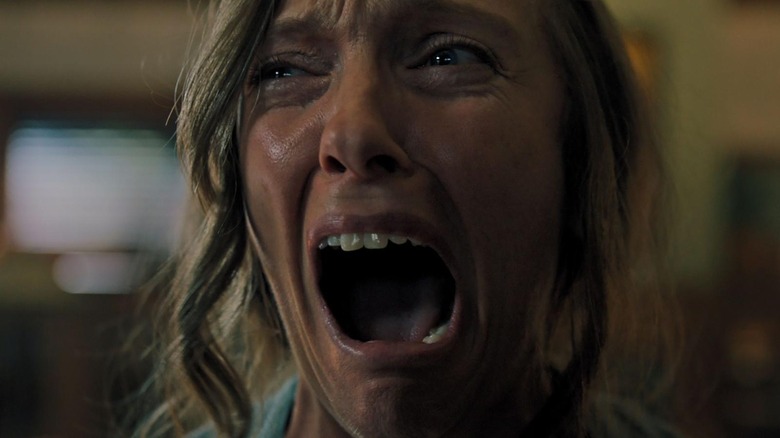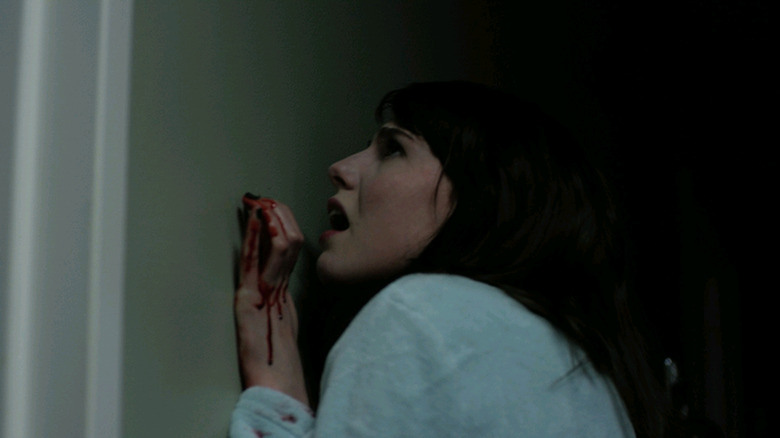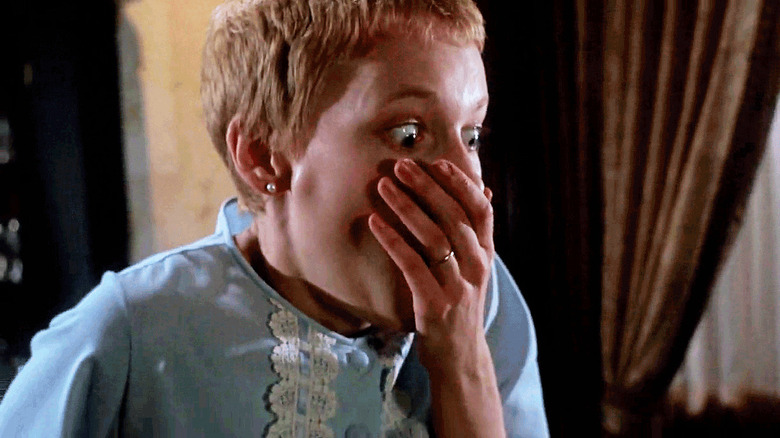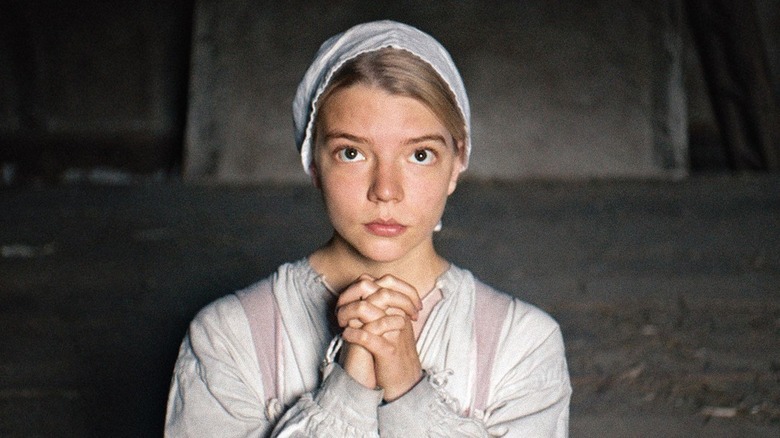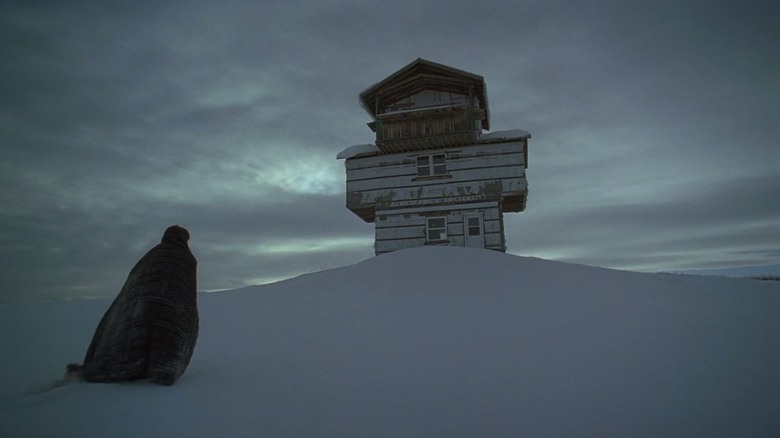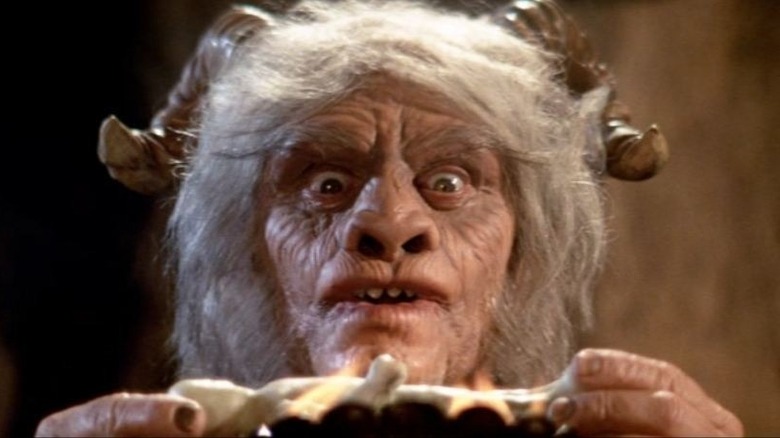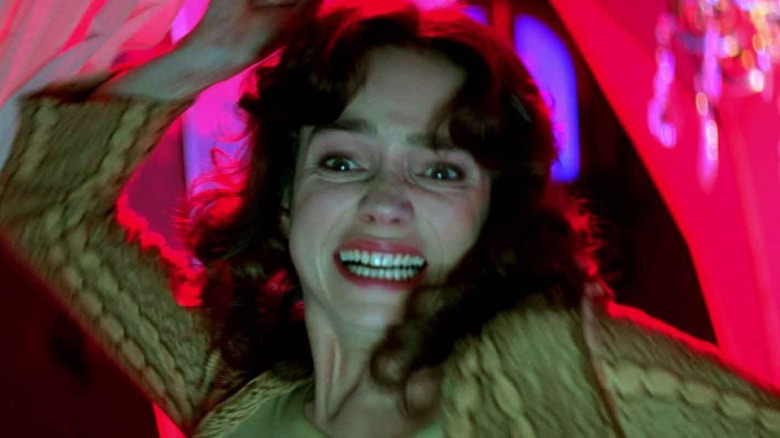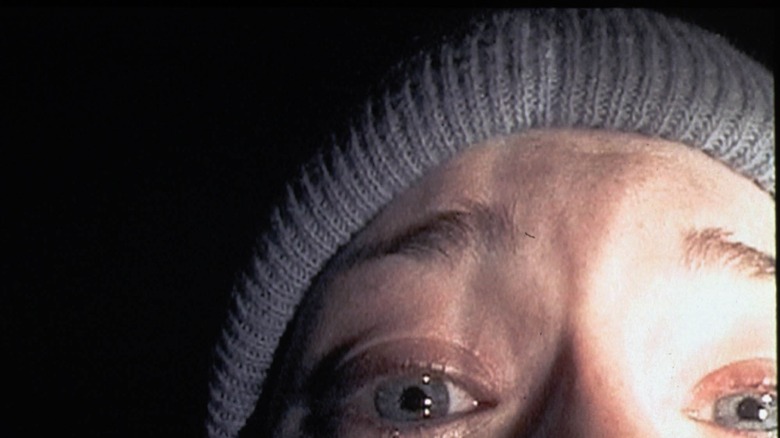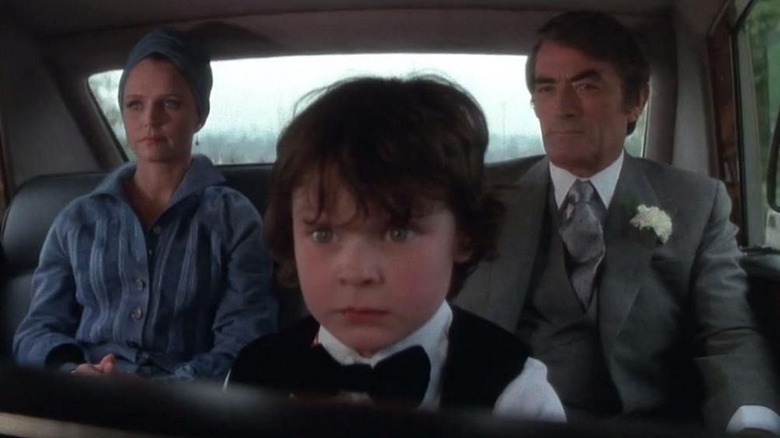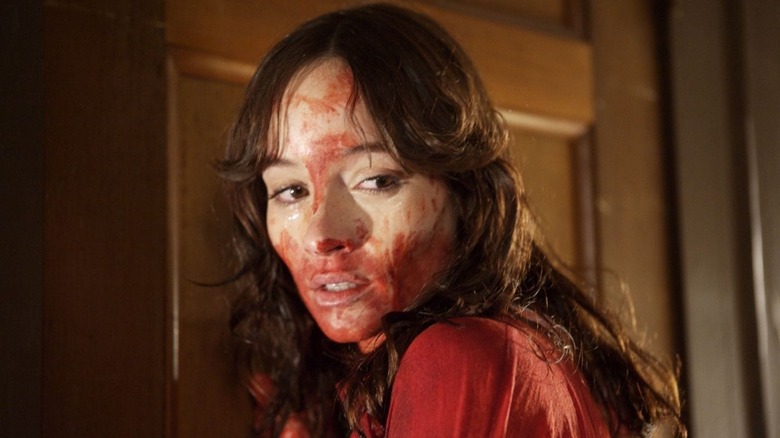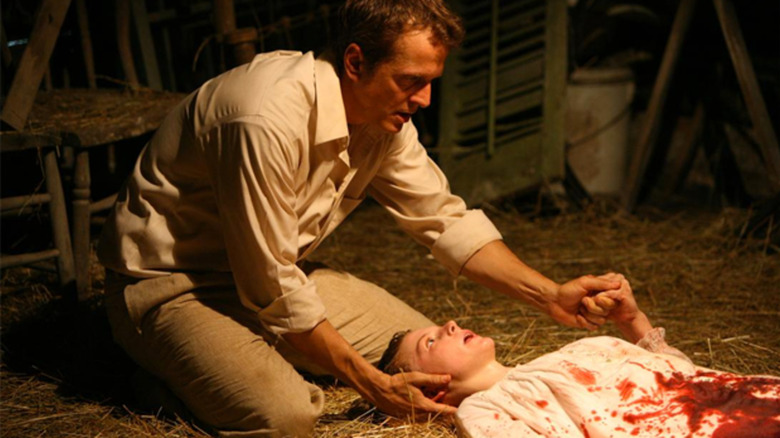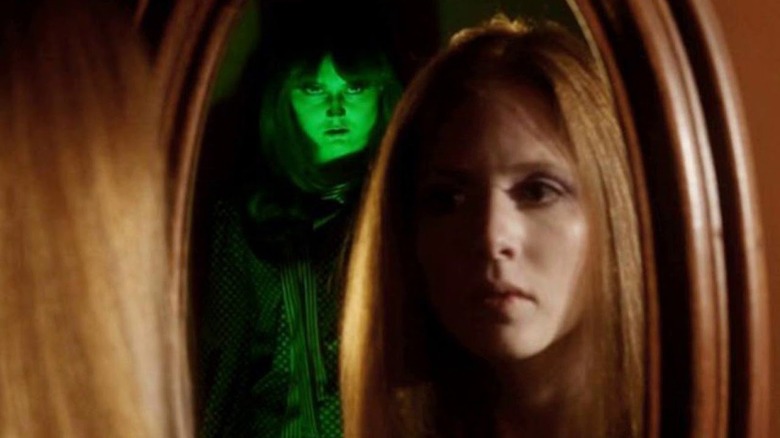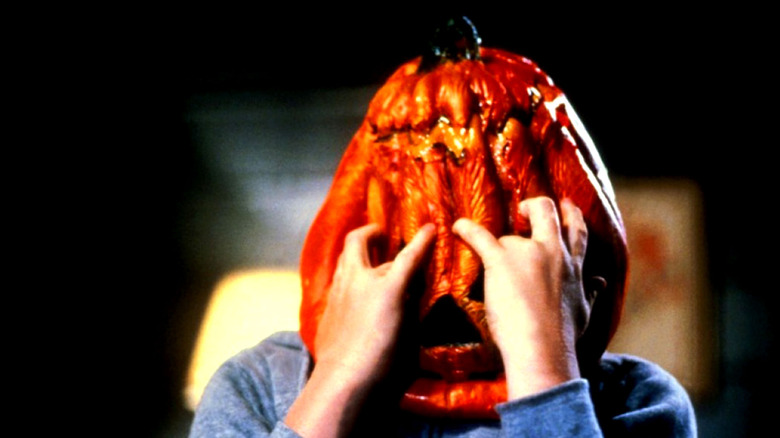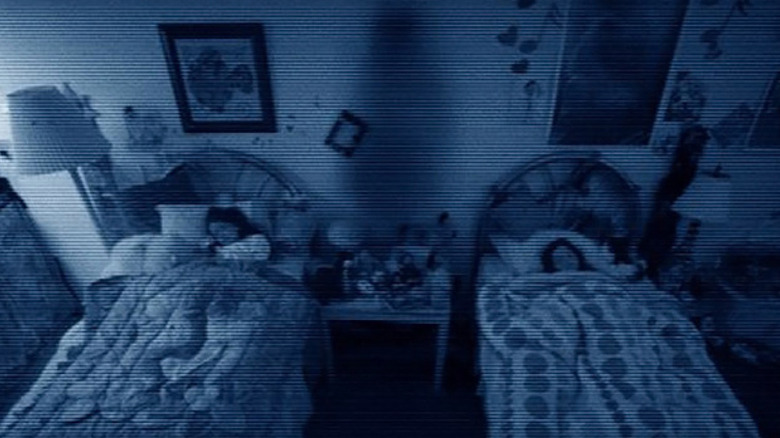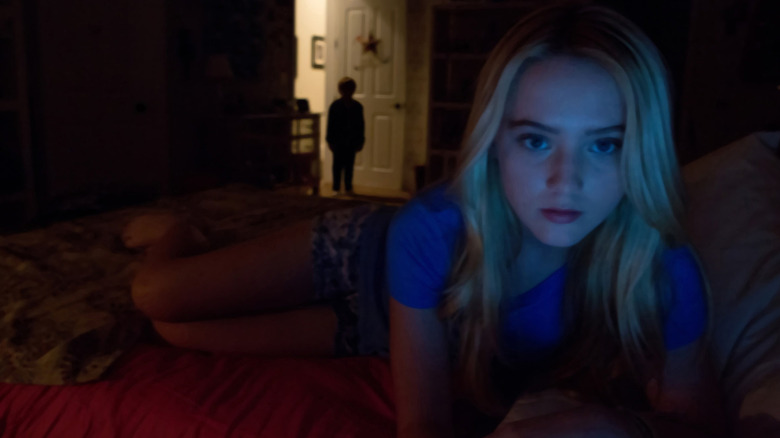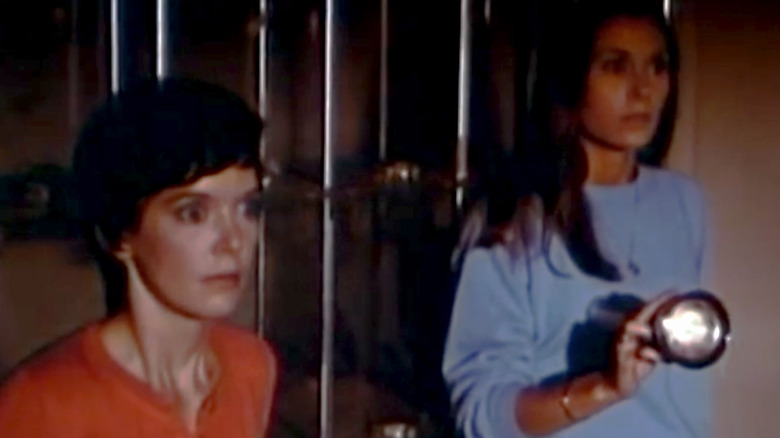15 Movies Like Hereditary You Need To Watch Before You Die
When writer/director Ari Aster's "Hereditary" was released in 2018, it became part of the discourse about "elevated horror" — that is, horror that was viewed as being above regular slasher fare/gorefests in its themes and approach. No end of think pieces can be found discussing whether "elevated horror" is a subgenre or not, and "Hereditary" has been in the mix since it made its critical mark.
At its core, "Hereditary" is a film about family dynamics and how they break down. Aster slowly ramps up the tension of his psychological thriller until it's almost unbearable, then unleashes the family secret: demon worship, which is where the grotesque horror creeps in. Toni Collette plays Annie, a miniaturist whose relationship with her recently deceased mother was chock full of angst, and whose family life with husband Steve, daughter Charlie, and son Peter is strained. We come to find out that Annie's mom was the head of a coven seeking to bring the reign of a demon named Paiman to Earth, using one of Annie's children as the vessel.
Demon-worshipping cults and good old-fashioned Satanism are a staple of the horror genre, elevated or not, and there are many good — and not-so-good, but fun — ones to sate your appetite. So get your altar set up for a bunch of films like "Hereditary" to watch before you die — or become a host for something not of this realm. Note: There may be spoilers.
The Blackcoat's Daughter
In 2015's "The Blackcoat's Daughter," writer/director Osgood Perkins crafts a rich tale of loneliness that leads to a shocking, bloody act. There's a mixed timeline, too, to keep things off-kilter while layering on the dread. Kiernan Shipka of "Mad Men" plays Kat, a lonely freshman who has visions of her parents dying. She wants someone — anyone — to pay attention to her. Lucy Boynton's Rose, on the other hand, is a senior who would not mind if her parents ignore her for a bit, as she fears she's pregnant and needs time to figure out a plan. Both are students at The Bramford Academy, a Catholic girl's boarding school where the nuns dress like it's the 1850s.
Meanwhile, Joan, played by Emma Roberts, is a woman who doesn't talk much, even as she's helped by a couple with a tragic past one winter's night. It's hard to tell at first when the stories of Kat, Rose, and Joan are taking place, but there's talk of devil-worshipping which Rose throws in as a gossipy story that Kat takes very seriously.
Perkins, the son of actor Anthony Perkins of "Psycho" fame, plants hints throughout of what's to come in the final act, whether it's bumper stickers on a car or quick flashbacks to violence that begin to look familiar. While there's no group of cultists as in "Hereditary," there is a growing feeling — as in that film — that something demonic is about to happen and that it's wanted.
Rosemary's Baby
Roman Polanski's 1968 adaptation of Ira Levin's 1967 novel, "Rosemary's Baby," is considered a classic of occult horror. A young couple, Rosemary and Guy Woodhouse (Mia Farrow and John Cassavetes), move into the Bramford apartment building in New York City. They find their neighbors, Minnie and Roman Castevet, friendly but also a bit intrusive. Guy seems to like the elderly couple, who are played by Ruth Gordon and Sidney Blackmer, while Rosemary is stand-offish. Despite a friend telling them of the Bramford's dark past, the young couple don't seem to be connecting the dots to the behavior of their neighbors and the rumors of witchcraft. Well, at least, Rosemary doesn't seem to.
After Rosemary gets pregnant, more sinister events happen and Rosemary becomes increasingly paranoid and isolated. Guy's acting career is on an upswing, and he dismisses his wife's concerns. There are psychological games galore and a deep sense of dread, though Guy actively gaslights Rosemary, whereas in "Hereditary," Steve thinks Annie is losing her mind. Rosemary begins to figure out what her "kindly" neighbors really are — cultists who want to bring Satan's child into the world. Or maybe the child is Satan. The baby is described as having yellow eyes and horns in the book, though we don't get a good glimpse of him in the film.
By the way, if the Bramford name sounds familiar, it is — the academy in "The Blackcoat's Daughter" was named after it as a homage.
The Witch
In Robert Eggers' directorial debut, "The Witch," which he also wrote, a young girl named Thomasin is scapegoated as a witch because of the torments her family endures. Eggers sets his tale in the 1630s, where a Puritan family is banished from its colony, ostensibly due to religious reasons. In this case, Thomasin's father appears to be more stringently religious than pretty much anyone around. He makes Thomasin's life miserable, and that's even before the accusations of witchcraft start flying.
The film is meticulously detailed thanks to Eggers' extensive research into the period. Anya Taylor-Joy shows every nuance of Thomasin's isolation and oppressed lifestyle. Under the surface, the film explores how women were boxed into strict roles with little to no agency of their own, and how their fates followed that of the men in their lives. When Thomasin uncovers the real reason her family was all-but-excommunicated, thanks to her father's stubbornness and hubris, it's no wonder she makes the choice she does when the family goat, Black Phillip, asks her if she wants to "live deliciously." Oh, yeah, the film also has a talking goat.
In addition to Taylor-Joy, "The Witch" features Ralph Ineson as Thomasin's father, William, and Kate Dickie as her mother, Katherine. The film is genuinely unsettling, and the ending still generates a lot of discussion.
The Lodge
"The Lodge" is a slow-burning trip into the psyche of Grace, a woman who survived a religious cult only to find that her past still follows her. Severin Fiala and Veronika Franz, who directed 2014's eerie "Goodnight Mommy," return with another psychological tale of terror as the introverted Grace, played by Riley Keough, goes on a vacation with her boyfriend and his two young children for the first time.
Unfortunately, the children, Aiden (Jaeden Martell) and Mia (Lia McHugh), blame Grace for the breakup of their parents' marriage and the tragedy of their mother's death. Richard Armitage's Richard has to leave them alone with Grace after he is called back to town for an emergency. The three become snowbound in the lodge in the middle of nowhere when strange occurrences begin.
"The Lodge" trades in the same atmospheric dread and ambiguity as "Goodnight Mommy," while also including two traumatized children. Has Grace really shed her own trauma from her cult days, or is she still troubled enough to harm Mia and Aiden? Or should she fear the children?
Though there aren't any witches around, there are occult trappings and the kind of religious fervor that also drove Thomasin to her own choices in "The Witch" and the cult to go after Annie's kids in "Hereditary." While "The Lodge" is not quite at the same level of creepiness as "Goodnight Mommy," there are still plenty of scares in this forbidding psychological drama.
The Devil's Rain
For pure occult freakishness, it's hard to beat "The Devil's Rain," the 1975 horror extravaganza known for being John Travolta's film debut, as well as the film for which the William Shatner "death mask" was cast that was later used to create Michael Myers' iconic look. Besides Shatner, the film also stars Ernest Borgnine, Tom Skerritt, Eddie Albert, Ida Lupino, and Keenan Wynn, with Church of Satan founder Anton LaVey providing technical assistance.
The 1970s was a time when "Satanic Panic" was beginning to take hold, and this real-life fear of course crept into the era's horror films. In "The Devil's Rain," Shatner plays Mark Preston, whose family has been cursed by Borgnine's evil Jonathan Corbis because they have an occult tome he wants. When Mark decides to challenge Corbis for possession of the book, things get crazy. Corbis plans to use Mark in a Satanic ritual, and it's up to Mark's family to save him. Skerritt plays Mark's brother, Tom, and Albert appears as a psychic researcher because occult films need an expert to explain all the Satanic shenanigans. There's also a goat, sort of — Corbis' demon form includes giant curved goat horns. It also turns out that these Satanists and the Wicked Witches of Oz have something in common.
The plot gets a bit convoluted, including finding out just what the Devil's Rain is, and the ending is a bit downbeat. But for absolute face-melting fun, "The Devil's Rain" is a must-see film.
Suspiria
The original version of "Suspiria" from 1977 is a dark, bloody giallo by Italian horror-master Dario Argento, who directed and co-wrote the screenplay with the late Daria Nicolodi from a book by Thomas De Quincey. In the film, Suzy Bannion, played by Jessica Harper, goes to a renowned dance school in Germany to study ballet. What she finds behind the dance lessons is bloody murder perpetrated by a coven of witches.
Suzy is aided in her investigations by a psychiatrist and an occult professor, and discovers the dance academy was founded by a witch. If the head witch dies, the coven dies with her. From there it's up to Suzy to discover the identity of the head witch and save herself from becoming the coven's next victim.
"Suspiria" is moody and foreboding, but soaked in color, as there are slashings and bloody deaths galore. And if you liked the maggots in "Hereditary," you will love the ones here that rain down on the students, although they don't emanate from a severed head.
Both Argento and Nicolodi show up in uncredited minor roles. A remake with Dakota Johnson and Tilda Swinton, who plays three roles, was released in 2018 and includes Harper in a cameo appearance. It's hard to beat the original, though, for gruesome witchy terror.
The Blair Witch Project
"The Blair Witch Project" is upfront about its witchery. The 1999 low-budget shocker was made for $60,000 and earned $248,639,099 worldwide. It spurred a new wave of found footage filmmaking and fooled some audiences into believing its three leads were really missing out in the woods near Burkittsville, Maryland.
The story is simple. Three students, Heather, Josh, and Mike — played by Heather Donahue, Joshua Leonard, and Michael Williams, respectively — go missing. Their footage is found and reconstructed to show how they headed out to the woods to investigate the legend of the murderous Blair Witch. They also learn of a child-killer named Rustin Parr before they begin their journey. Before long, they are terrorized by an unseen force and become lost, running around in circles trying to find their way out of the woods. Josh disappears first. Heather and Mike find an abandoned cabin and are attacked. The footage cuts off before their fates are revealed.
Though not nearly as successful in starting a franchise the way "Paranormal Activity" later did, the film was hugely influential. For a fan of "Hereditary," seeing a different approach to witches and occult occurrences is also hugely fun and frightening. See it before your next camping trip to properly prepare yourself for late-night eerie shenanigans.
The Omen
As far as classic tales of the devil's son go, it's hard to beat "The Omen" from 1976. A U.S. diplomat whose wife delivers a stillborn child is persuaded to surreptitiously adopt a baby whose mother died in childbirth. He doesn't tell his wife about the baby swap, and they name their "son" Damien.
Five years later, weird events transpire, all seemingly centered around Damien. The diplomat, Robert, played by magisterial actor Gregory Peck, eventually becomes an ambassador to the U.K. His wife, Katherine, played by Lee Remick, is pregnant, making her unborn child Damien's target. It doesn't help that the family is soon also the target of Satanists, one of whom infiltrates the family, or that the mother who died birthing Damien turns out to be a jackal. Damien also has the Mark of the Beast on his head. Oops — the little boy Robert adopted is the Antichrist.
As with "The Devil's Rain," "The Omen” was made during a time when Satanism was beginning to loom large in the popular consciousness. Directed by Richard Donner, "The Omen" also features David Warner, Billie Whitelaw, and little Harvey Stephens as Damien. There are also a bunch of snarling Rottweilers, gruesome "accidental" deaths, and a lesson in not trusting a random priest who urges you to replace your stillborn child with another. "The Omen" spawned three sequels, one of which — "Omen III: The Final Conflict" — stars Sam Neill as a grown-up Damien. A remake starring Liev Schreiber was released in 2006.
The House of the Devil
Director/writer Ti West's third feature film, "The House of the Devil," was released in 2009 but is deliberately styled like a 1980s horror film. The film slowly builds suspense before exploding in a frenzy of monstrousness. A young college student, Samantha, played by Jocelin Donahue, agrees to "grandmom"-sit for a creepy couple in a creepy mansion because she needs the $400 they are willing to pay for her to stick around while they go do creepy things. Something doesn't seem right, but Samantha has a back-up plan: Her friend, Greta Gerwig's Megan, will pick her up at a set time and make sure she's okay.
"The House of the Devil" shares with "Hereditary" a series of small events which escalate into bigger, more frightening doings, ending with a horrific act by cultists trying to bring yet another demon into the world. While the pace of "The House of the Devil" is a bit slower, the journey fits with the '80s aesthetic West is going for — the 1980's was when "Satanic Panic" reached its full force – and the homage pays off in a bonkers sequence with a surprising and devastating ending. Tom Noonan and cult actress Mary Woronov play the creepy couple with their own nefarious plans for Samantha, and Lena Dunham has a voice-only role as a 911 operator.
The Last Exorcism
"The Last Exorcism" goes all in on questions of faith and motivation. The 2010 feature is styled like a documentary as Cotton Marcus, a reverend, discusses how he performs fake exorcisms. Cotton's lost his faith in God after a personal tragedy, and wants to expose how exorcisms are bunk.
To show the filmmakers what he means, Cotton, played by Patrick Fabian from "Better Call Saul," agrees to investigate the possession of Nell Sweetzer, played by Ashley Bell. Cotton rigs a few tricks before the exorcism to prove to the documentarians that the "possession" isn't real, and that Nell is probably mentally ill. After he "casts out" her demon, he's ready to leave, but Nell continues to exhibit bizarre behavior and her family believes she needs religious assistance. Cotton wants to help what he feels is a disturbed girl, especially after he learns she is pregnant, so he stays. The events that follow test his limits and his faith in ways he thought weren't possible.
Once again, demons and children and cultists come together to provide some visceral horror with an extra dose of spirituality thrown in. The documentary style makes the horror feel more real, and Bell's contortion skills are no special effect. The film has a shocking ending sure to unsettle you the same way "Hereditary" does.
Season of the Witch
Witchy women return in George A. Romero's little-seen 1973 shocker, "Season of the Witch." Starring Jan White as Joan Mitchell, a bored housewife whose husband Jack is abusive, the film was heavily edited and marketed as a softcore film under the title "Hungry Wives." Romero, who also wrote the screenplay, did not write it as a sexploitation romp, however, going for a more thoughtful exploration of women's lives under the patriarchy.
Joan's life changes when she meets Virginia Greenwald's Marion, the leader of a secret coven who teaches Joan all about witchcraft. It doesn't take long before Joan dives deeper into the occult, and as always happens with that sort of study, strange and unexplainable things begin happening. Joan's coming into her own power as a woman causes friction with her 19-year-old daughter, who winds up running off. Also, while Joan's awakening does include a sexual component, it's not the main one. Romero's film strives for a feminist depiction of women constricted by the patriarchal norms of the times. In this case, it takes Satan and witchcraft to help Joan unlock her full potential.
Halloween III: Season of the Witch
When John Carpenter and Debra Hill decided to make a sequel to the very successful 1978 "Halloween," they envisioned an anthology series with different stories for each entry. Unfortunately, "Halloween II" was already being made as a direct continuation of the original film's story, with demonic Michael Myers returning to murder even more teenagers.
Carpenter and Hill persevered, however, resulting in the only "Halloween" film not to feature The Shape and his iconic butcher knife. Instead, they marry witchcraft to science fiction and go all out with it. Tommy Lee Wallace directs Tom Atkins as Daniel Challis, an alcoholic doctor who winds up trying to stop Dan O'Herlihy's Cochran, the owner of Silver Shamrock Novelties, from reviving witchcraft by sacrificing as many children as possible on Halloween. The masks made by Silver Shamrock contain bits of Stonehenge through which Cochran's plan will come to fruition. Oh, and there are androids.
Despite Carpenter and Hill's enthusiasm for an anthology franchise, "Halloween III: Season of the Witch" did not do well with critics and audiences. Because of the two prior films, audiences expected Myers to show up, and when he didn't, they turned away. The film has gone through several re-evaluations since then, and while it's not "elevated horror," it's worth a look, especially if you like a little weird, somewhat nonsensical sci-fi jammed into your occultism.
Paranormal Activity 3
Writer/director Oren Peli made 2007's "Paranormal Activity" on a budget of $15,000. It wound up earning a whopping $193,355,800 worldwide after its 2009 wide release, spawning several sequels, each of which has connected in some way to the original while devising new uses for its found footage conceit.
In "Paranormal Activity," Katie and Micah move in together and discover that a demon is stalking Katie. The next film backtracks to reveal that the demon, nicknamed "Toby," plagued Katie and her sister, Kristi, when they were children, and now wants Kristi's son, Hunter. Kristi's husband performs a ritual to attach the demon to Katie, but it doesn't work how he anticipates. Part of the film overlaps timewise with the original movie.
"Paranormal Activity 3" takes the prequel route back to Katie and Kristi's 1988 childhood, as contained in a stack of VHS home movies discovered in Kristi's attic after the events in "Paranormal Activity 2." The tapes show that Toby appears because Katie and Kristi's grandmother, Lois, is part of a coven that made a deal with the devil. The problem, as in "Hereditary," is that the demon needs a male host, and neither Lois nor her daughter, Julie, have sons. Kristi is the next best thing until a male heir is born. That's pretty horrible grandparenting, if you ask us!
"Paranormal Activity 3" is co-directed by Henry Joost and Ariel Schulman from Christopher Landon's screenplay, though Peli gets a writing credit for "Paranormal Activity" and also produces.
Paranormal Activity 4
"Paranormal Activity 4" is a direct sequel to "Paranormal Activity 2." After the prequel that was the third entry in the franchise, co-directors Henry Joost and Ariel Schulman, working from a script by Christopher Landon and with Chad Feehan contributing to the story, pick the tale up after Katie has been possessed. She and her nephew, Hunter, are now missing.
Enter a new family, the Nelsons. The Nelsons live in Arizona and have a neighbor we don't see whose son, Robbie, has an invisible friend named — you guessed it — Toby. The daughter, Alex, helps watch her little brother, Wyatt, and Robbie while Robbie's mother is hospitalized. Sure enough, haunted happenings begin again, and Alex, played by Kathryn Newton, and her friend, Ben, played by Matthew Shively, try to capture the spooky events on camera. As shown in the previous entries, Toby dislikes being on-camera and becomes angry. Things naturally escalate until we find out where Katie and Hunter have been and the coven returns.
The consistency in direction and story between "Paranormal Activity 3" and "Paranormal Activity 4" adds to its complexity without making the whole tale feel convoluted. New details are added to the rituals the coven must follow in order to complete their goals, which may have dire consequences for poor, virginal Alex, not to mention all her family and friends. There are also updated effects involving webcams that, while not as scary as the fan-cam from "Paranormal Activity 3," still manage to create tension.
Satan's School for Girls
The lure of the burgeoning "Satanic Panic" subgenre wasn't contained to theatrical releases in the 1970's — even television got in on the terror. Such is the case with 1973's "Satan's School for Girls," a made-for-TV movie which got a theatrical remake in 2000 starring Shannon Doherty.
Pamela Franklin appears as Elizabeth, whose sister commits suicide — except that Elizabeth doesn't believe her happy sister would ever perform such an act. Elizabeth is convinced something happened at the tony private school her sister attended before her untimely death. The name of that school? The Salem Academy for Women. We mean, that's a tip-off right there that something's amiss.
At Salem Academy, Elizabeth runs into all kinds of weirdness and a couple of future stars of "Charlie's Angels," Kate Jackson and Cheryl Ladd, who was then known as Cheryl Stoppelmoor. She also meets someone who may be Satan himself, as well as — you guessed it — a coven of witches. At Salem Academy. Who could have guessed?
While "Satan's School for Girls" is dated, it's still pretty spooky for a TV movie, especially given the standards and constraints of the time. The already-prolific Aaron Spelling produced, with David Lowell Rich directing from an Arthur A. Ross screenplay. Other big '70s stars such as Lloyd Bochner, Roy Thinnes, and Jo Van Fleet appear in major roles. It's definitely worth seeking out, especially for fans of Jackson, who has a role in the 2000 remake.
